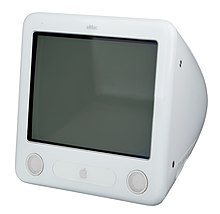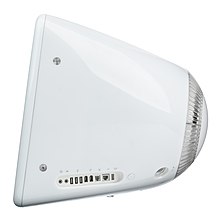eMac
 | |
 The Apple eMac | |
| Developer | Apple Computer |
|---|---|
| Type | Desktop/All in One |
| Release date | April 29, 2002 |
| Introductory price | US$1,099 (equivalent to $1,860 in 2023) |
| Discontinued | July 5, 2006 |
| CPU | PowerPC 7450, 700 MHz–1.42 GHz |
| Display | 17 in (43 cm) flat CRT, 1280 x 960 |
| Mass | 50 lb (23 kg) |
| Predecessor | iMac G3 |
| Successor | iMac (Intel-based) |
The eMac (short for education Mac) is an all-in-one Macintosh desktop computer that was produced and designed by Apple Computer Released in 2002, it was originally aimed at the education market, but was later made available as a cheaper mass-market alternative to Apple's second-generation LCD iMac G4. The eMac was pulled from retail on October 12, 2005, and was again sold exclusively to educational institutions thereafter. It was discontinued by Apple on July 5, 2006, and replaced by a cheaper, low-end iMac G5 that, like the eMac, was exclusively sold to educational institutions.
The eMac design closely resembles the first-generation iMac, though the eMac is white, slightly larger in size, and heavier than the preceding G3, weighing 50 lb (23 kg).[1] The unique shape of the computer was also similar to the 17-inch CRT Studio Display from 2000 (the last standalone CRT monitor Apple made). The Apple eMac features a PowerPC 7450 (G4e) processor that is significantly faster than the previous-generation PowerPC 750 (G3) processor, as well as a 17-inch flat CRT display, which was aimed at the education market, as LCD screens would be expensive.
Overview

The eMac generally catered to the mass market, eventually taking over the entry-level (previously held by the iMac G3) Macintosh from 2003 to 2005, while the iMac G4 was positioned as a premium offering throughout the lifetime of the eMac line.[2] The eMac generally offered similar performance and features to the iMac G4 while they were sold side by side. The eMac was gradually supplanted by the iMac G5 in 2005 to 2006.
Apple introduced the eMac in April 2002. The eMac was originally intended exclusively for education buyers, but the demand for it was high enough that it was made available for general retail one month later. In the retail market, it was positioned as a lower-cost alternative to the recently released second-generation PowerPC 7400 iMac G4. The new iMac's LCD, which at the time was significantly more costly than a CRT, made it considerably more expensive than its G3 predecessor, so the eMac was considered the more affordable upgrade for those looking for more processing power than the iMac G3.
The eMac featured a 17-inch (430 mm) flat-screen CRT monitor, a Freescale PowerPC G4 processor running at 700 or 800 MHz, Nvidia GeForce2 MX graphics, and built-in 18-watt stereo speakers. The retail models were priced at US$1,099 and US$1,499 which filled the price gap between the US$799 iMac G3 and the US$1,499 iMac G4 similar pricing of its predecessor. This revision came with faster processor speeds (800 MHz and 1 GHz) and replaced the GeForce2 MX display adapter with an ATI Radeon 7500 display adapter.
In October 2003, 800 MHz model was eliminated as a standard configuration and the 1 GHz model was brought down in price. This revision was the last in the line to officially run Apple's OS 9 operating system natively.
The next revision to the eMac line came in April 2004, with DDR SDRAM, a faster processor running at 1.25 GHz, and a better ATI Radeon 9200 video chipset. The most recent revision came in May 2005, with an even faster CPU running at 1.42 GHz, Radeon 9600 graphics, and larger standard hard disk.
On October 12, 2005, Apple once again restricted sales of the eMac to educational institutions and returned to its "E is for Education" marketing plan that had been attached to the product from the original restriction to education buyers. The company re-implemented this restrictive measure for unspecified reasons. Some analysts believe Apple wanted to force the general public to purchase the more expensive Mac Mini or iMac which had higher profit margins. Also, the eMac was the only CRT display product left in Apple's lineup which made it somewhat bulky compared to new offerings which had compact form factors due to their LCD screens. The falling cost of LCD displays would also gradually bring down the prices of the iMac G5. However, the eMac was still available for sale to the general public through some third-party retailer websites.

On July 5, 2006, the entire eMac line was discontinued. An "educational configuration" of the iMac Core Duo was introduced that same day, which has a Combo drive rather than a SuperDrive and a smaller hard disk of 80 GB.
Early eMac models natively boot Mac OS 9.2.2 and Mac OS X beginning with OS X 10.1.4, while later models only officially boot Mac OS X. 1 GHz and faster models cannot boot OS 9, while eMacs slower than 1 GHz do not officially support 10.5 (requirements are an 867 MHz G4 with 512 MB RAM).
Technical problems
A number of early eMac machines have suffered from what was known as "Raster Shift", a phenomenon where the bottom third or half of the screen goes black, with the rest of image shifting upward and beyond the top boundary of the display. Serious static also accompanies the problem, rendering the viewable part of the screen virtually useless. In response to the problem, Apple offered a solution which involved the replacement of the video cable inside the eMac's case.[3][4] Certain models of eMac also suffered from capacitor plague, that caused video distortion or the computer to lock up.[5] Apple responded to these issues by implementing a warranty extension program.[6]
Technical Specifications
All are standard configurations from Apple unless otherwise noted
| Model | Formal name | eMac[7] | eMac (ATI Graphics)[8] | eMac (USB 2.0)[9] | eMac (2005)[10] | ||
|---|---|---|---|---|---|---|---|
| Codename | "P69" | "Northern Lights" | "114P" | "Q86J" | |||
| Timetable | Released | April 22, 2002 | August 13, 2002 | May 6, 2003 | April 13, 2004 | May 3, 2005 | |
| Discontinued | May 6, 2003 | October 22, 2003 | April 13, 2004 | May 3, 2005 | October 12, 2005 (retail) / July 5, 2006 (education) | ||
| Identifier | Model | A1002 (EMC 1903) | A1002 (EMC 1955) | A1002 (EMC None) | |||
| ID | PowerMac4,4 | PowerMac6,4 | |||||
| Order info. | M8655 | M8892 | M9150 | M8950 | M9425 | M9834 | |
| Display | 17-inch (16-inch viewable) 1280 x 960 flat CRT | ||||||
| Performance | Processor | 700 MHz PowerPC G4 (7441) | 800 MHz PowerPC G4 (7441) | 800 MHz PowerPC G4 (7445) | 1 GHz PowerPC G4 (7445) | 1.25 GHz PowerPC G4 (7447A) 1 GHz for education only |
1.42 GHz PowerPC G4 (7447B) 1.25 GHz for education only |
| CPU cache | 64 KB L1, 256 KB L2 (1:1) | 64 KB L1, 512 KB L2 on chip (1:1) | |||||
| Front side bus | 100 MHz | 133 MHz | 167 MHz | ||||
| Memory | 128 MB of PC133 SDRAM (256 MB for 1 GHz SuperDrive model) Expandable up to 1 GB |
256 MB of 333 MHz PC2700 DDR SDRAM (512 MB for 1.42 GHz SuperDrive model) Expandable up to 2 GB (officially only 1 GB is supported)[11][a][12][a] | |||||
| Graphics | NVIDIA GeForce 2 MX with 32 MB of DDR SDRAM | ATI Radeon 7500 with 32 MB of DDR SDRAM | ATI Radeon 9200 with 32 MB of DDR SDRAM | ATI Radeon 9600 with 64 MB of DDR SDRAM ATI Radeon 9200 with 32 MB of DDR SDRAM for education only | |||
| AGP 2x | AGP 4x | ||||||
| Storage | Hard drive | 40 GB | 40 GB, 60 GB[a], 80 GB[a] | 40 GB, 80 GB[a] | 40 GB, 80 GB[a], 120 GB[a], 160 GB[a] | ||
| Ultra ATA/66 | Ultra ATA/100 | ||||||
| Optical drive | 32x CD-ROM | 2X SuperDrive (DVD-RW) | Combo Drive (CD-RW/DVD-ROM) standard or SuperDrive (DVD-RW)[a] CD-RW Standard for initial 700 MHz model CD-ROM Standard for 800 MHz refresh SuperDrive Standard for initial 800 MHz model | ||||
| Connections | Connectivity | AirPort 802.11b[b] 10/100 BASE-T Ethernet 56k V.90 modem |
AirPort Extreme 802.11b/g[b] 10/100 BASE-T Ethernet 56k V.92 modem |
AirPort Extreme 802.11b/g[b] 10/100 BASE-T Ethernet 56k V.92 modem (optional on education 1.25 GHz models) Optional Bluetooth 1.1 | |||
| Peripherals | 3x USB 1.1 2x FireWire 400 Built-in 18-watt stereo speakers |
3x USB 2.0 2x FireWire 400 Built-in 16-watt stereo speakers |
3x USB 2.0 2x FireWire 400 Built-in 18-watt stereo speakers | ||||
| Video out | Mini-VGA at up to 1280x960 (mirrored mode only). Unofficially, can be altered to support extended display mode in models with ATI graphics using a tool called Screen Spanning Doctor. | ||||||
| Operating System | Original | Mac OS X 10.1.4 "Puma" and Mac OS 9.2.2 | Mac OS X 10.2.6 "Jaguar" Mac OS 9.2.2[a] |
Mac OS X 10.2.6 "Jaguar" | Mac OS X 10.3.3 "Panther" | Mac OS X 10.4 "Tiger" | |
| Maximum | Mac OS X 10.4 "Tiger" and Mac OS 9.2.2 | Mac OS X 10.5 "Leopard" | |||||
| Weight | 50 lb / 22.7 kg | ||||||
Timeline of iMac models
| Timeline of iMac and eMac models (sorted by screen sizes) |
|---|
 |
Notes
References
- ^ Royal, Simon (April 13, 2012). "Looking Back at the 1.25 GHz eMac". lowendmac.com. Archived from the original on April 2, 2021. Retrieved January 14, 2021.
- ^ Wood, Molly (January 14, 2005) [June 10, 2004]. "Apple eMac PPC Review". CNET. Archived from the original on April 16, 2017. Retrieved July 16, 2016.
- ^ "ALERT: Fix for the eMac "raster shift" problem - CNET". Reviews.cnet.com. September 2, 2009. Archived from the original on July 21, 2012. Retrieved July 16, 2016.
- ^ "Procedure to Replace the IVAD Cable". Welovemacs.com. Archived from the original on August 17, 2016. Retrieved July 16, 2016.
- ^ "eMac logic board failures (#2): AppleCare reminder; Blown capacitors". CNET. CNET. Archived from the original on September 27, 2022. Retrieved September 9, 2020.
- ^ "Odds and Ends: Apple offers eMac Repair Extension Program for Video and Power Issues". CNET. CNET. Archived from the original on September 27, 2022. Retrieved September 9, 2020.
- ^ "eMac – Technical Specifications". Apple Support. Archived from the original on September 8, 2008. Retrieved August 31, 2008.
- ^ "eMac (ATI Graphics) – Technical Specifications". Apple Support. Archived from the original on September 8, 2008. Retrieved August 31, 2008.
- ^ "eMac (USB 2.0) – Technical Specifications". Apple Support. Archived from the original on September 14, 2008. Retrieved August 31, 2008.
- ^ "eMac (2005) – Technical Specifications". Apple Support. Archived from the original on September 15, 2008. Retrieved August 31, 2008.
- ^ "Apple eMac G4/1.25 (USB 2.0) Specs (M9425LL/A) - Technical Specifications @ EveryMac.com". EveryMac.com. Archived from the original on June 30, 2012. Retrieved October 12, 2008.
- ^ "Apple eMac G4/1.42 (2005) Specs (M9834LL/A) @ EveryMac.com". EveryMac.com. Archived from the original on July 3, 2012. Retrieved October 12, 2008.
